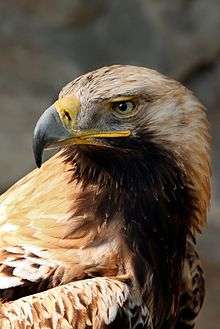Eastern imperial eagle
| Eastern imperial eagle | |
|---|---|
 | |
| Juvenile moulting into adult plumage at the Little Rann of Kutch | |
| Scientific classification | |
| Kingdom: | Animalia |
| Phylum: | Chordata |
| Class: | Aves |
| Order: | Accipitriformes |
| Family: | Accipitridae |
| Genus: | Aquila |
| Species: | A. heliaca |
| Binomial name | |
| Aquila heliaca Savigny, 1809 | |
| Synonyms | |
|
Aquila heliaca heliaca | |
The eastern imperial eagle (Aquila heliaca) is a large species of bird of prey that breeds from southeastern Europe to western and central Asia. Most populations are migratory and winter in northeastern Africa and southern and eastern Asia.[2] The Spanish imperial eagle found in Spain and Portugal, was formerly lumped with this species, the name imperial eagle being used in both circumstances. However, the two are now regarded as separate species[3] due to significant differences in morphology,[4] ecology[2] and molecular characteristics.[5][6]

Description
The eastern imperial eagle is a large eagle with a length of 72–90 cm (28–35 in), a wingspan of 1.8–2.16 m (5.9–7.1 ft) and a weight of 2.45–4.55 kilograms (5.4–10.0 lb). Females are about a quarter larger than males.[2][7][8] It closely resembles the Spanish imperial eagle, but has far less white to the "shoulder" and it is slightly larger.[2]
Habitat and breeding
In Europe, the eastern imperial eagle is threatened with extinction. It has nearly vanished from many areas of its former range, e.g. Hungary and Austria.[1] Today, the only European populations are increasing in the Carpathian basin, mainly the northern mountains of Hungary and the southern region of Slovakia. The breeding population in Hungary consists of about 105 pairs.[9] The most western breeding population on the border between Austria and Czech Republic consists of 25–30 pairs and is mostly non-migratory.
There are many eastern imperial eagle nests in the Bulgaria/Turkey section of the European Green Belt (the uncultivated belt along the former Iron Curtain.)
The monarchy of Austria-Hungary once chose the imperial eagle to be its heraldic animal, but this did not help this bird. The eagle's preferred habitat is open country with small woods; unlike many other species of eagle, it does not generally live in mountains, large forests or treeless steppes.
Eastern imperial eagles generally prefer to construct a nest in a tree which is not surrounded by other trees, so that the nest is visible from a considerable distance, and so that the occupants may observe the surroundings unobstructed. Tree branches are taken in order to build the nest, which is upholstered with grass and feathers. Very rarely it nests on cliffs or the ground.[2]
In March or April the female lays two to three eggs. The chicks hatch after about 43 days and leave the nest after 60–77 days.[2] Often, however, only one will survive to leave the nest, with the others dying before becoming fully fledged. In at least a part of its range, more than a third of all nesting attempts are entirely unsuccessful.[2]
The eastern imperial eagle feeds mainly on hares, hamsters and pheasants as well as a variety of other birds and mammals.[9]
References
- 1 2 BirdLife International (2013). "Aquila heliaca". IUCN Red List of Threatened Species. Version 2015.2. International Union for Conservation of Nature.
- 1 2 3 4 5 6 7 Meyburg, B.U. (1994). del Hoyo; Elliott; Sargatal, eds. Eastern Imperial Eagle (Aquila heliaca). Handbook of the Birds of the World. Vol. 2. pp. 194–195. ISBN 84-87334-15-6.
- ↑ Sangster, George; Knox, Alan G.; Helbig, Andreas J.; Parkin, David T. (2002). "Taxonomic recommendations for European birds". Ibis. 144 (1): 153–159. doi:10.1046/j.0019-1019.2001.00026.x.
- ↑ Cramp, S.; Simmons, K.E.L. (1980). Birds of the Western Palearctic. Vol. 2. Oxford: Oxford University Press.
- ↑ Padilla, J.A.; Martinez-Trancón, M.; Rabasco, A.; Fernández-García, J.L. (1999). "The karyotype of the Iberian imperial eagle (Aquila adalberti) analyzed by classical and DNA replication banding". Cytogenetics and Cell Genetics. 84: 61–66. doi:10.1159/000015216.
- ↑ Seibold, I.; Helbig, A.J.; Meyburg, B.U.; Negro, J.J.; Wink, M. (1996). Meyburg, B.U.; Chancellor, R.D., eds. "Genetic differentiation and molecular phylogeny of European Aquila eagles (Aves: Falconiformes) according to cytochrome-b nucleotide sequences" (PDF). Eagle Studies. Berlin: World Working Group on Birds of Prey: 1–15.
- ↑ Ferguson-Lees, J.; Christie, D. (2001). Raptors of the World. Houghton Mifflin Harcourt. ISBN 0-618-12762-3.
- ↑ Ali, Salim (1993). The Book of Indian Birds. Bombay: Bombay Natural History Society. ISBN 0-19-563731-3.
- 1 2 Horváth, M.; et al. (2010). "Spatial variation in prey composition and its possible effect on reproductive success in an expanding eastern imperial eagle (Aquila heliaca) population" (PDF). Acta Zoologica Academiae Scientiarum Hungaricae. 56: 187–200.
External links
| Wikimedia Commons has media related to Aquila heliaca. |
| Wikispecies has information related to: Aquila heliaca |
- BirdLife species factsheet for Aquila heliaca
- "Aquila heliaca". Avibase.

- "Eastern imperial eagle media". Internet Bird Collection.
- Imperial eagle photo gallery at VIREO (Drexel University)
- Interactive range map of Aquila heliaca at IUCN Red List maps
- Audio recordings of Eastern imperial eagle on Xeno-canto.
